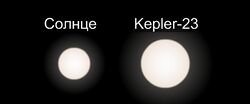Astronomy:Kepler-23
| Observation data Equinox J2000.0]] (ICRS) | |
|---|---|
| Constellation | Cygnus[1] |
| Right ascension | 19h 36m 52.5356s[2] |
| Declination | +49° 28′ 45.253″[2] |
| Apparent magnitude (V) | 14.0[3] |
| Characteristics | |
| Spectral type | G5[4] |
| Astrometry | |
| Proper motion (μ) | RA: 2.262±0.030[2] mas/yr Dec.: 3.851±0.031[2] mas/yr |
| Parallax (π) | 1.1678 ± 0.0161[2] mas |
| Distance | 2,790 ± 40 ly (860 ± 10 pc) |
| Details | |
| Mass | 1.11[3] M☉ |
| Radius | 1.52 ± 0.24[3] R☉ |
| Luminosity | 0.79 ± 0.04[3] L☉ |
| Temperature | 5760 ± 124[3] K |
| Metallicity [Fe/H] | –0.09 ± 0.14[3] dex |
| Rotational velocity (v sin i) | [3] km/s |
| Other designations | |
| Database references | |
| SIMBAD | data |
| KIC | data |
Kepler-23 is a star in the northern constellation of Cygnus, the swan. It is orbited by three known exoplanets. With an apparent visual magnitude of 14.0,[3] this star is too faint to be seen with the naked eye.
Planetary system
Planets b and c were discovered in 2011 and were confirmed in 2012.[6] An additional planet d was discovered in 2014.
| Companion (in order from star) |
Mass | Semimajor axis (AU) |
Orbital period (days) |
Eccentricity | Inclination | Radius |
|---|---|---|---|---|---|---|
| b | 0.478+0.010−0.0091 MJ | 0.075 | 7.106995 | — | — | 0.1511±0.0068 RJ |
| c | 0.189+0.036−0.033 MJ | 0.099 | 10.742434 | — | — | 0.278±0.0089 RJ |
| d | 0.055+0.043−0.037 MJ | 0.124 | 15.27429±0.00017 | — | — | 0.1994±0.0079 RJ |
| Discovery | |
|---|---|
| Discovered by | Kepler science team [citation needed] |
| Discovery date | 2014 [9] |
| Transit method | |
| Orbital characteristics | |
| 0.1240 AU [10] | |
| Orbital period | 0.0418 [10] |
| Star | Kepler-23 |
| Physical characteristics | |
| Mass | 0.0550 (MJ) [10] |
Kepler 23d
Kepler-23d is a super-Earth candidate orbiting the star Kepler-23, located in the constellation Cygnus.[10] The planet is 2.2 times wider than Earth[9] and is 0.0550 Jupiter masses.[10] The planet was located using data from the Kepler space telescope in 2014,[9] and was concluded to likely be a super-Earth.[9]
Habitability
The planet is a Venus-like exoplanet due to its proximity from its star; roughly 0.1240 AU away.[10] The planet hypothetically has a surface, although it would be almost similar to Venus’s landscape.[citation needed]
References
- ↑ "Cygnus – constellation boundary", The Constellations, International Astronomical Union, http://www.iau.org/public/constellations/#cyg, retrieved 2011-12-15
- ↑ 2.0 2.1 2.2 2.3 2.4 Brown, A. G. A. (August 2018). "Gaia Data Release 2: Summary of the contents and survey properties". Astronomy & Astrophysics 616: A1. doi:10.1051/0004-6361/201833051. Bibcode: 2018A&A...616A...1G. Gaia DR2 record for this source at VizieR.
- ↑ 3.0 3.1 3.2 3.3 3.4 3.5 3.6 3.7 Kepler-23b, NASA Ames Research Center, http://kepler.nasa.gov/Mission/discoveries/kepler23b/, retrieved 2011-12-06
- ↑ 4.0 4.1 Schneider, Jean, Star: Kepler-23, http://exoplanet.eu/star.php?st=Kepler-23, retrieved 2011-12-06
- ↑ "Kepler-23". SIMBAD. Centre de données astronomiques de Strasbourg. http://simbad.u-strasbg.fr/simbad/sim-basic?Ident=Kepler-23.
- ↑ Ford, Eric B.; Fabrycky, Daniel C.; Steffen, Jason H.; Carter, Joshua A.; Fressin, Francois; Holman, Matthew J.; Lissauer, Jack J.; Moorhead, Althea V. et al. (2012), "Transit Timing Observations Fromkepler. Ii. Confirmation of Two Multiplanet Systems Via a Non-Parametric Correlation Analysis", The Astrophysical Journal 750 (2): 113, doi:10.1088/0004-637X/750/2/113, Bibcode: 2012ApJ...750..113F
- ↑ Rowe, Jason F.; Bryson, Stephen T.; Marcy, Geoffrey W.; Lissauer, Jack J.; Jontof-Hutter, Daniel; Mullally, Fergal; Gilliland, Ronald L.; Issacson, Howard et al. (2014), Validation of Kepler's Multiple Planet Candidates. III: Light Curve Analysis & Announcement of Hundreds of New Multi-planet Systems, doi:10.1088/0004-637X/784/1/45, Bibcode: 2014ApJ...784...45R
- ↑ Van Eylen, Vincent; Albrecht, Simon (2015), "Eccentricity from Transit Photometry: Small Planets in Kepler Multi-Planet Systems Have Low Eccentricities", The Astrophysical Journal 808 (2): 126, doi:10.1088/0004-637X/808/2/126, Bibcode: 2015ApJ...808..126V
- ↑ 9.0 9.1 9.2 9.3 "Kepler-23 d Eyes on Exoplanets". https://exoplanets.nasa.gov/eyes-on-exoplanets/#/planet/Kepler-23_d/.
- ↑ 10.0 10.1 10.2 10.3 10.4 10.5 "Kepler-23 d exoplanet kyoto". http://www.exoplanetkyoto.org/exohtml/Kepler-23_d.html.
Coordinates: ![]() 19h 36m 52.0s, +49° 28′ 45″
19h 36m 52.0s, +49° 28′ 45″
 |


